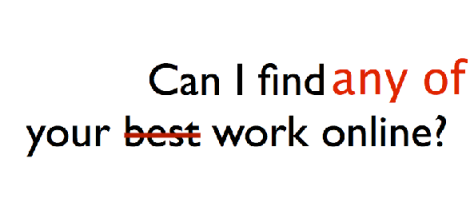If you are an educator, you need a blog.
It’s 2015.
Where are you creating your digital identity?
Where do you share resources with other educators?
Where do you reflect on your practice?
Where are you having conversations about learning and teaching?
Where do you model the learning we want to see in every classroom?
How do you demonstrate the Standards of Practice of the profession?
Where do you maintain a professional portfolio?

Last evening we had a rich conversation in the #OSSEMOOC open mic around why educators are not blogging.
1. Not enough time.
Educators are the hardest working people I know, hands down. No contest. They would NEVER think of not preparing for classes or not providing feedback on student work.
Isn’t blogging and sharing and reflecting just as important? How long does it take to share a few thoughts online? How long does it take to upload a file to share?
2. Fear of judgment.
Creating a safe environment for risk-taking is a classroom priority. Why do we make it hard for our colleagues to share their practice? Do our students feel they will be judged when we ask them to share? How do we model to our students that learning and sharing and growing together is a valuable use of our time?
3. Don’t know how.
Get started here:
Start connecting here: https://ossemooc.wordpress.com/2014/11/01/ten-minutes-of-connecting-day-1/
Why you need to make thinking visible through blogging here:
Why you need to start your own blog here:
How to start your blog here:
How others use their blogs (modelling) here: https://ossemooc.wordpress.com/2014/11/25/ten-minutes-of-connecting-day-25-you-have-a-blog-now-what/
How to turn your blog into a professional portfolio here:
Making your blog YOUR online space for sharing:
https://ossemooc.wordpress.com/2014/11/28/ten-minutes-of-connecting-day-27-more-blog-considerations/
4. It’s not really valued.
You are right. It isn’t. At least not yet.
Until we teach in the B.Ed. program that open reflective practice and demonstration of the Standards of Practice of the profession is a necessity, we won’t see it.
Until we ask to see a blog with every job application, be it teacher, principal or system leader, we won’t value it.
Until every PQP and SOQP course makes open sharing, connecting, collaborating, reflecting and learning important, we won’t insist on it.
But let’s not wait!
The value in reflecting, sharing, conversing, connecting and honouring our amazing work in schools is obvious.
Let’s tell our own stories of the learning happening in our classrooms and schools. The stories are powerful.
Share them widely.
Special thanks to @timrobinsonj for sharing pixabay.com






















